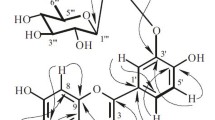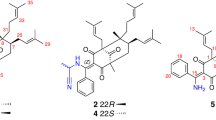Abstract
The Peruvian plant Lepidium meyenii (Maca) has been shown to possess neuroprotective activity both in vitro and in vivo [1–3]. Previous studies have also demonstrated the activity of the pentane extract and its macamides, the most representative lipophilic constituents of Maca, in the endocannabinoid system as fatty acid amide hydrolase (FAAH) inhibitors. One of the most active macamides, N-3-methoxybenzyl-linoleamide [4, 5], was studied to determine its mechanism of interaction with FAAH and whether it has inhibitory activity on mono-acyl glycerol lipase (MAGL), the second enzyme responsible for endocannabinoid degradation [6]. Macamide concentrations from 1 to 100 μM were tested using FAAH and MAGL inhibitor assay methods and showed no effect on MAGL. Tests with other conditions were performed in order to characterize the inhibitory mechanism of FAAH inhibition. N-3-methoxybenzyl-linoleamide displayed significant time-dependent and dose-dependent FAAH inhibitory activity. The mechanism of inhibition was most likely irreversible or slowly reversible. These results suggest the potential application of macamides isolated from Maca as FAAH inhibitors, as they might act on the central nervous system to provide analgesic, anti-inflammatory, or neuroprotective effects, by modulating the release of neurotransmitters.






Similar content being viewed by others
References
Pino-Figueroa A (2009) In vivo and in vitro neuroprotective effects of the pentane soluble compounds from Lepidium meyenii (Maca). Dissertation, Massachusetts College of Pharmacy and Health Sciences University
Pino-Figueroa A, Nguyen D, Maher TJ (2010) Neuroprotective effects of Lepidium meyenii (Maca). Ann N Y Acad Sci 1199:77–85
Pino-Figueroa A, Vu H, Kelley CJ, Maher TJ (2011) Mechanism of action of Lepidium meyenii (Maca): an explanation for its neuroprotective activity. Am J Neuroprotec Neuroregen 3:87–92
Wu H (2011) Macamides and their synthetic analogs as potential FAAH inhibitors. Dissertation, Massachusetts College of Pharmacy and Health Sciences University
Vu H., (2012) Fatty acid amide hydrolase (FAAH) inhibitors: discovery in Lepidium meyenii (Maca) extracts. In: Conference Proceedings of The National Conference On Undergraduate Research (NCUR), Weber State University, Utah, 29–31 March 2012, 410-417
Mechoulam R, Spatz M, Shohami E (2002) Endocannabinoids and neuroprotection. Sci STKE 2002:1–6
Kumar RN, Chambers WA, Pertwee RG (2001) Pharmacological actions and therapeutic uses of cannabis and cannabinoids. Anaesthesia 56:1059–1068
Pertwee RG (2006) Cannabinoid pharmacology: the first 66 years. Br J Pharmacol 147(Suppl 1):S163–S171
Rhee MH, Bayewitch M, Avidor-Reiss T, Levy R, Vogel Z (1998) Cannabinoid receptor activation differentially regulates the various adenylyl cyclase isozymes. J Neurochem 71:1525–1534
Freund TF, Katona I, Piomelli D (2003) Role of endogenous cannabinoids in synaptic signaling. Physiol Rev 83:1017–1066
Day TA, Rakhshan F, Deutsch DG, Barker EL (2001) Role of fatty acid amide hydrolase in the transport of the endogenous cannabinoid anandamide. Mol Pharmacol 59:1369–1375
Shohami E, Cohen-Yeshurun A, Magid L, Algali M, Mechoulam R (2011) Endocannabinoids and traumatic brain injury. Br J Pharmacol 163:1402–1410
van der Stelt M, Di Marzo V (2005) Cannabinoid receptors and their role in neuroprotection. Neuromol Med 7:37–50
Fowler CJ, Rojo ML, Rodriguez-Gaztelumendi A (2010) Modulation of the endocannabinoid system: neuroprotection or neurotoxicity? Exp Neurol 224:37–47
Pacher P, Bátkai S, Kunos G (2006) The endocannabinoid system as an emerging target of pharmacotherapy. Pharmacol Rev 58:389–462
Hwang J, Adamson C, Butler D, Janero DR, Makriyannis A, Bahr BA (2010) Enhancement of endocannabinoid signaling by fatty acid amide hydrolase inhibition: a neuroprotective therapeutic modality. Life Sci 86:615–623
Pertwee RG (2001) Cannabinoid receptors and pain. Prog Neurobiol 63:569–611
van der Stelt M, Veldhuis WB, van Haaften GW, Fezza F, Bisogno T, Bär PR, Veldink GA, Vliegenthart JFG, Di Marzo V, Nicolay K (2001) Exogenous anandamide protects rat brain against acute neuronal injury in vivo. J Neurosci 21:8765–8771
Franklin A, Parmentier-Batteur S, Walter L, Greenberg DA, Stella N (2003) Palmitoylethanolamide increases after focal cerebral ischemia and potentiates microglial cell motility. J Neurosci 23:7767–7775
Schomacher M, Muller HD, Sommer C, Schwab S, Schabitz WR (2008) Endocannabinoids mediate neuroprotection after transient focal cerebral ischemia. Brain Res 1240:213–220
Shouman B, Fontaine RH, Baud O, Schwendimann L, Keller M, Spedding M, Lelièvre V, Gressens P (2006) Endocannabinoids potently protect the newborn brain against AMPA-kainate receptor-mediated excitotoxic damage. Br J Pharmacol 148:442–451
Gallily R, Breuer A, Mechoulam R (2000) 2-Arachidonylglycerol, an endogenous cannabinoid, inhibits tumor necrosis factor-alpha production in murine macrophages, and in mice. Eur J Pharmacol 406:R5–R7
Cravatt BF, Lichtman AH (2003) Fatty acid amide hydrolase: an emerging therapeutic target in the endocannabinoid system. Curr Opin Chem Biol 7:469–475
Ahn K, Smith SE, Liimatta MB, Beidler D, Sadagopan N, Dudley DT, Young T, Wren P, Zhang Y, Swaney S, Van Becelaere K, Blankman JL, Nomura DK, Bhattachar SN, Stiff C, Nomanbhoy TK, Weerapana E, Johnson DS, Cravatt BF (2011) Mechanistic and pharmacological characterization of PF-04457845: a highly potent and selective fatty acid amide hydrolase inhibitor that reduces inflammatory and noninflammatory pain. J Pharmacol Exp Ther 338:114–124
Gonzales GF, Gonzales C, Gonzales-Castaneda C (2009) Lepidium meyenii (Maca): a plant from the highlands of Peru–from tradition to science. Forsch Komplementmed 16:373–380
Muhammad I, Zhao J, Dunbar DC, Khan IA (2002) Constituents of Lepidium meyenii 'Maca'. Phytochem 59:105–110
Zhao J, Muhammad I, Dunbar DC, Mustafa J, Khan IA (2005) New alkamides from Maca (Lepidium meyenii). J Agric Food Chem 53:690–693
Ahn K, Johnson DS, Fitzgerald LR, Liimatta M, Arendse A, Stevenson T, Lund ET, Nugent RA, Nomanbhoy TK, Alexander JP, Cravatt BF (2007) Novel mechanistic class of fatty acid amide hydrolase inhibitors with remarkable selectivity. Biochemistry 46:13019–13030
Boger DL, Miyauchi H, Du W, Hardouin C, Fecik RA, Cheng H, Hwang I, Hedrick MP, Leung D, Acevedo O, Guimarães CRW, Jorgensen WL, Cravatt BF (2005) Discovery of a potent, selective, and efficacious class of reversible α-ketoheterocycle inhibitors of fatty acid amide hydrolase effective as analgesics. J Med Chem 48:1849–1856
Muccioli GG, Labar G, Lambert DM (2008) CAY10499, a novel monoglyceride lipase inhibitor evidenced by an expeditious MGL assay. ChemBioChem 9:2704–2710
Tian G, Paschetto KA, Gharahdaghi F, Gordon E, Wilkins DE, Luo X, Scott CW (2011) Mechanism of inhibition of fatty acid amide hydrolase by sulfonamide-containing benzothiazoles: long residence time derived from increased kinetic barrier and not exclusively from thermodynamic potency. Biochemistry 50:6867–6878
Scott CW, Tian G, Yu XH, Paschetto KA, Wilkins DE, Meury L, Cao CQ, Varnes J, Edwards PD (2011) Biochemical characterization and in vitro activity of AZ513, a noncovalent, reversible, and noncompetitive inhibitor of fatty acid amide hydrolase. Eur J Pharmacol 667:74–79
Lopera-Mesa TM, Doumbia S, Chiang S, Zeituni AE, Konate DS, Doumbouya M, Keita AS, Stepniewska K, Traore K, Diakite SA, Ndiaye D, Sa JM, Anderson JM, Fay MP, Long CA, Diakite M, Fairhurst RM (2013) Plasmodium falciparum clearance rates in response to artesunate in Malian children with malaria: effect of acquired immunity. J Infect Dis 207(11):1655–1663
Ning M, Li L, Li J, Li Z, Li R, Zhou T, Lu W (2012) In vitro screening of reversible and time-dependent inhibition on CYP3A by TM208 and TM209 in rat liver microsomes. Acta Pharm Sin B 2:181–187
Kage KL, Richardson PL, Traphagen L, Severin J, Pereda-Lopez A, Lubben T, Davis-Taber R, Vos MH, Bartley D, Walter K, Harlan J, Solomon L, Warrior U, Holzman TF, Faltynek C, Surowy CS, Scott VE (2007) A high throughput fluorescent assay for measuring the activity of fatty acid amide hydrolase. J Neurosci Methods 161:47–54
Boger DL, Sato H, Lerner AE, Hedrick MP, Fecik RA, Miyauchi H, Wilkie GD, Austin BJ, Patricelli MP, Cravatt BF (2000) Exceptionally potent inhibitors of fatty acid amide hydrolase: the enzyme responsible for degradation of endogenous oleamide and anandamide. Proc Natl Acad Sci U S A 97:5044–5049
Silverman R (2002) The organic chemistry of enzyme-catalyzed reactions. Elsevier, Oxford
Voet D, Voet J, Pratt C (2008) Chapter 12. Enzyme kinetics, inhibition, and regulation. In: Principles of biochemistry, Wiley, New York
McCollom MM, Villinski JR, McPhail KL, Craker LE, Gafner S (2005) Analysis of macamides in samples of Maca (Lepidium meyenii) by HPLC-UV-MS/MS. Phytochem Anal 16:463–469
Petrosino S, Di Marzo V (2010) FAAH and MAGL inhibitors: therapeutic opportunities from regulating endocannabinoid levels. Curr Opin Investig Drugs 11:51–62
Lewis RA, Robin JL (1985) Arachidonic acid derivatives as mediators of asthma. J Allergy Clin Immunol 76:259–264
Cunningham FM, Woollard PM, Camp RD (1985) Proinflammatory properties of unsaturated fatty acids and their monohydroxy metabolites. Prostaglandins 30:497–509
Acknowledgments
We thank the American Association of Colleges of Pharmacy (AACP)-NIA Program-2012 for the invaluable support to the present study.
Author information
Authors and Affiliations
Corresponding author
Rights and permissions
About this article
Cite this article
Almukadi, H., Wu, H., Böhlke, M. et al. The Macamide N-3-Methoxybenzyl-Linoleamide Is a Time-Dependent Fatty Acid Amide Hydrolase (FAAH) Inhibitor. Mol Neurobiol 48, 333–339 (2013). https://doi.org/10.1007/s12035-013-8499-2
Received:
Accepted:
Published:
Issue Date:
DOI: https://doi.org/10.1007/s12035-013-8499-2




